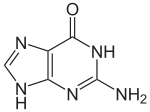Structural Biochemistry/Organic Chemistry/Nucleic Acids (DNA)
Structure and Terminology of Nucleic Acids
[edit | edit source]Deoxyribonucleic acid (DNA) and Ribonucleic acid (RNA) are the two types of nucleic acids. The structure of DNA differs from RNA only because the DNA molecule does not have a hydroxyl group on the 2' carbon atom of the sugar ring. The missing hydroxyl group keeps DNA from being hydrolyzed, making it more stable than the ribose sugar of RNA.
The sugars in nucleic acids are bonded together by a phosphodiester bond between the 3' carbon on one sugar and the 5' carbon on another sugar.
The phosphodiester bond is negatively charged to repel nucleophilic attack by hydroxide ions and is less susceptible to hydrolytic attack. This negative charge, as well as the lack of a hydroxide group on the 2' carbon of DNA, makes the DNA molecule more stable than the RNA molecule, which could explain why DNA is the hereditary information carrier of all cells.
The chain of sugars made by the phosphodiester bonds form the backbone of the nucleic acids. The backbone of every nucleic acid is the same, but each sugar can contain one of four different bases. Two of the bases, (A)adenine and guanine (G), are derivatives of purine. The other two bases, cytosine (C) and thymine (T) are derivatives of pyrimidine.
Ribose, unlike deoxyribose, contains a base called uracil (U) instead of the base thymine (T). Thymine has an extra methyl group on the 5-carbon atom, making it slightly different than Uracil.
A nucleoside is a combination of a sugar and a base.
The nucleosides in DNA are called deoxyadenosine, deoxyguanosine, deoxycytidine, and thymidine, and the nucleosides in RNA are called adenosine, guanosine, cytidine, and uridine. If the base is a purine, then the N-9 (nitrogen) is bonded to the C-1' (carbon) of the sugar. If the base is a pyrimidine, then the N-1 is bonded to the C-1' of the sugar.
A nucleotide is a nucleoside joined to one or more phosphate groups by ester linkages. Therefore, it consists of the sugar, base, and phosphate(s). Nucleotides are the monomers that form DNA and RNA strands.
Most nucleotides are formed by the attachment of a phosphate group to the C-5' of the sugar. However, some nucleotides are also formed by the attachment of the phosphate group to the C-3' of the sugar. The four nucleotides that compose DNA are called deoxyadenylate, deoxyguanylate, deoxycytidylate, and thymidylate.
A DNA chain has polarity. One end of the chain will have a free 5' OH group. The other end will have a free 3' OH group. By convention, the base sequence of a DNA strand is written from the 5' to the 3' end.
The three-dimensional structure of DNA is a double helix. The two helices are coiled around a common axis and they run in opposite directions. The hydrophilic backbone of the helices make the outside of the helix, while the hydrophobic bases make up the inside of the helix. The helical structure of DNA is stabilized by the hydrogen bonding between complementary base pairs. Purines are larger than pyrimidines, so in order to have a regular structure, base pairs are formed between one purine and one pyrimidine. The base pairs of DNA are adenine (A) with thymine (T) and guanine (G) with cytosine (C). In RNA the thymine is replaced with uracil (U). The DNA structure is further stabilized by van der Waals forces between stacks of base pairs and the rigid five-membered ring structure of the backbone sugars.
RNA is nucleic acid, and its single-stranded, helical structure is constructed by nucleotides of nitrogenous bases, a ribose sugar, and phosphate group(s); the bases that make up RNA are adenine, guanine, cytosine, and uracil, for which, 1’ nitrogen of pyrimidine base and 9’ nitrogen of purines base are bonded to 1’carbon of pentose sugar by glycosidic bond; base pairs of adenine and uracil are hydrogen bonded to cytosine and guanine, respectively; the ribose is a pentose sugar of carbon numbered from 1’ to 5’ and has a hydroxyl group on the 2’ carbon; the 3’ and 5’ carbons of ribose sugar are bonded to phosphate group by phosphodiester bond; more importantly, the structure is of A-form geometry, which is constructed as of vast and thin major groove and of flat and broad minor groove, the structure can fold on itself to form secondary structure, such as tRNA and rRNA, and the secondary structure that are stabilized by hydrogen bonds, domains of loops, and metal ions, such as Mg 2+, form specific tertiary form.
List of Nitrogenous bases found in DNA and RNA
[edit | edit source]| Name | Abbreviation | Structure | Classification | Found in |
|---|---|---|---|---|
Cytosine |
C |
 |
Pyrimidine | DNA, RNA |
Thymine |
T |
 |
Pyrimidine | DNA |
Uracil |
U |
 |
Pyrimidine | RNA |
Adenine |
A |
 |
Purine | DNA, RNA |
Guanine |
G |
 |
Purine | DNA, RNA |
References
[edit | edit source]Berg, Jeremy; Tymoczko, John; Stryer, Lubert. Biochemistry, 6th edition. W.H. Freeman and Company. 2007.



